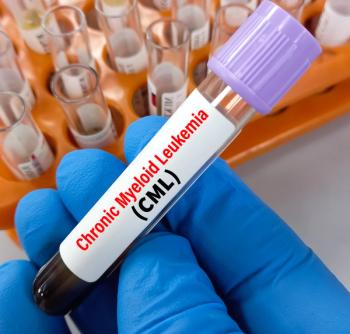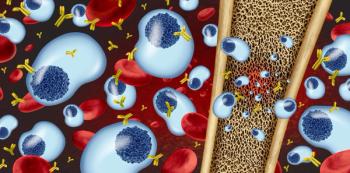
- January 2014 The Aging Population
- Volume 80
- Issue 1
Rheumatoid Arthritis: Walking the Walk
The struggles of managing rheumatoid arthritis and how pharmacists can help are illustrated through one patient's experience.
The struggles of managing rheumatoid arthritis and how pharmacists can help are illustrated through one patient’s experience.
Meet Ed. Ed is a 75-year-old mechanic who suffers from rheumatoid arthritis (RA). One of 1.5 million Americans with RA,1,2 he experiences severe pain, stiffness, and inflammation. Both hands are misshapen with deformed joints, and at its most painful, he forgoes recreational activities because of his disability. He has trouble with some of the finer tasks he used to do with ease.
His rheumatologist can’t tell him why he developed RA, and says it’s linked to too many factors to pinpoint 1 cause—genetic, environmental, immunologic, and infectious. Like many RA patients,1-4 Ed has had several bouts of depression and anxiety. He attempted suicide once following extreme feelings of helplessness. At age 58, his depression was so serious he walked off the job and stayed home for 2 years, isolated and self-loathing. He returned to work but is now retired.
Ed’s progression typifies patients with RA in many respects, although women are 2.5 to 3 times more likely to have RA than men.1,2 Ed was diagnosed at 42 years of age when he noticed changes in the small joints of his fingers, wrist, and feet. After more than 30 years with RA, Ed has the condition in most joints, and also has some lung tissue damage, hardening of the arteries, and spinal deformity. In addition, rheumatoid vasculitis has reddened and irritated his skin. Table 1 summarizes RA’s clinical presentation.
Ed and Ed’s family ask often about a cure, but each time his rheumatologist responds, “We don’t have one yet.” The rheumatologist follows treatment guidelines, and Ed—a logical thinker who always reads the manual when he does any mechanical task—has appreciated knowing that his doctor follows an algorithm, too. The American College of Rheumatology (ACR) guidelines (updated in 2012 and available at
- Reduce pain and inflammation
- Slow or stop joint damage and disability progression
- Improve patients’ well-being and function
- Reduce or prevent long-term disease complications
Since his diagnosis indicating high disease activity and poor prognosis, Ed has used a multitreatment approach that starts with nonpharmacologic measures. Ed eats well, stretches each morning, exercises, and rests when he feels fatigued. During periods of depression, which he now recognizes sooner, he sees a mental health therapist. Periodically, he also sees a physical and an occupational therapist—this supports the ACR guideline goal of helping patients maintain use of affected joints and improve their overall quality of life.6
The Drugs: Progressively Better
Over the years, Ed has taken numerous drugs, switching when side effects occurred or pain increased. Throughout his disease, he took and continues to take acetaminophen and nonsteroidal anti-inflammatory drugs as needed. He has also been on corticosteroids, which he dislikes, and several disease-modifying antirheumatic drugs (DMARDs), hydroxychloroquine, minocycline, and methotrexate.4,7,8 He and his rheumatologist knew that they had other options (azathioprine, sulfasalazine, leflunomide, cyclosporine), but after discussion, they put them aside.1,2,4
In keeping with ACR guidelines, Ed’s rheumatologist used aggressive therapy early because it may delay or decrease joint destruction.7,9,10 He has also ensured that Ed’s vaccinations are current (eg, pneumococcal, influenza, hepatitis B, human papillomavirus, herpes zoster); people who have RA need as much protection as possible.5,6 Once the FDA started approving the biologic DMARDs (also called the biologic response modifiers; Online Table 2), Ed and his rheumatologist discussed risk-benefit. Ed was one of the first patients outside of clinical trials to use infliximab as an intravenous infusion every 2 months. He noticed improvement within 8 weeks, but he has also continued his methotrexate. When newer agents became available that could be given subcutaneously, he made an informed decision to remain on infliximab because he does not like giving himself shots.
Table 2: Biologic DMARDs Used to Treat RA
Agents
FDA Approval
Notes
Tumor necrosis factor (TNF) Inhibitors
inFLIXimab (Remicade)
August 24, 1998
- Infusion of biologics may cause fever, chills, body aches, and headache; consider premedicating with diphenhydramine.
- All are injectables administered subcutaneously or intravenous route depending on agent and each manufacturer’s recommendations.
- Used as monotherapy or in conjunction with methotrexate.
- Common side effects include upper respiratory infections, pneumonia, urinary tract infections, and skin infection, and nausea.
etanercept (Enbrel)
November 2, 1998
adalimunab (Humira)
December 31, 2002
certolizumab pegol (Cimzia)
April 22, 2008
golimumab (Simponi)
April 24, 2009
T-cell Costimulatory Blocking Agent
abatacept (Orencia)
December 23, 2005
- Given IV or subcutaneously.
- Responses typically observed within 3 months of therapy.
- Avoid live vaccines while on abatacept and for 3 months after discontinuation.
- Abatacept contains maltose and can falsely elevate blood glucose readings with certain blood glucose monitors on infusion days.
- Common side effects include headache, upper respiratory infection, sore throat, and nausea.
CD20-positive B-cell Depletion
riTUXimab (Rituxan)
March 1, 2006
- Used in combination with methotrexate in adults who exhibited inadequate responses to one or more TNF inhibitors.
- Patients should receive IV corticosteroid 30 minutes before each IV infusion.
- Common adverse effects may include hives, itching, swelling, difficulty breathing, fever, chills, and changes in blood pressure.
Interleukin-6 (IL-6) Receptor Antagonist
Tocilizumab (Actemra)
January 8, 2010
- Administered via IV infusion or subcutaneously and has associated REMS program.
- Increased risk of developing serious infections.
- Common ADRs include upper respiratory tract infections, nasopharyngitis, headache, hypertension, injection site reaction, and increased ALT.
Human Recombinant IL-1 Receptor Antagonist
Anakinra (Kineret)
November 14, 2001
- Administered subcutaneously.
- Most common ADRs: injection site pain, erythema, itching , fever, and nausea
For newly diagnosed patients, starting biologics within 6 months of symptom onset delays RA progression more effectively than later treatment. It may also prompt remission.4,5,7-10 Current ACR guidelines still encourage early treatment with the use of triple-combination DMARD regimens or a biologic with or without methotrexate for patients with high disease activity and a poor prognosis. However, the ACR guidelines do not recommend biologics for early RA in patients with low to moderate disease activity and good prognoses.7,6
In 2012, Ed switched to a new Janus kinase pathway inhibitor, tofacitinib (Xeljanz). Tired of infusions, he decided to try this new oral agent. He’s aware that it may elevate cholesterol and liver enzyme tests and decrease blood counts. It carries the same risk of serious infections and cancers as the biologic DMARDs. He finds that taking it twice daily is no problem. Tofacitinib allowed him to stop his methotrexate, and he hasn’t experienced tofacitinib’s most common adverse effects: upper respiratory tract infections, headache, diarrhea, and nasopharygitis.13,14
Final Note
RA patients like Ed are encouraged by recent drug and biologic approvals. Clinicians are too, and informed clinicians recommend early, aggressive treatment. The newer agents are also steroid-sparing, a benefit that patients and clinicians embrace. Pharmacists can help patients model Ed’s behaviors—he monitors his symptoms, partners in his treatment plan, and sees his health care professionals routinely.
Postscript: Ed passed away in his sleep in November 2013. His physicians suspect he had a fatal myocardial infarction. Due to his age and comorbidities, the family did not ask for an autopsy. At his memorial service, they noted his brave approach to this disabling disease.
Virginia Bartok, RPh, is a retired pharmacist and a professional writer. Her primary practice was in indigent care, and she currently provides case management for several geriatric patients.
References
- What is rheumatoid arthritis? National Institute of Arthritis and Musculoskeletal and Skin Diseases website. www.niams.nih.gov/Health_Info/Rheumatic_Disease/rheumatoid_arthritis_ff.asp. Accessed December 14, 2013.
- Rheumatoid arthritis. Centers for Disease Control and Prevention website. www.cdc.gov/arthritis/basics/rheumatoid.htm. Accessed December 14, 2013.
- Rheumatoid arthritis. American College of Rheumatology website. www.rheumatology.org/practice/clinical/patients/diseases_and_conditions/ra.asp. Accessed December 14, 2013.
- Depression in people with RA. Arthritis Foundation website. www.arthritis.org/research/funded-research/research-update/journal-summaries/depression-ra. Accessed December 14, 2013.
- Wilke W. Rheumatoid arthritis. www.clevelandclinicmeded.com/medicalpubs/diseasemanagement/rheumatology/rheumatoid-arthritis. Accessed December 14, 2013.
- 2012 Treatment guidelines for rheumatoid arthritis: an update from the American College of Rheumatology. Agency for Healthcare Research and Quality website. http://tinyurl.com/lexmr7p. Accessed December 14, 2013.
- Singh JA, Furst DE, Bharat A, et al. 2012 update of the 2008 American College of Rheumatology recommendations for the use of disease-modifying antirheumatic drugs and biologic agents in the treatment of rheumatoid arthritis. Arthritis Care Res. 2012;64(5):625-639.
- Drug therapy for rheumatoid arthritis in adults: an update. Department of Health and Human Services Agency for Healthcare Research and Quality website. www.effectivehealthcare.ahrq.gov/ehc/products/203/1044/CER55_DrugTherapiesforRheumatoidArthritis_FinalReport_20120618.pdf. Accessed December 14, 2013.
- Verstappen SM, Albada-Kuipers GA, Bijlsma JW, et al; for the Utrecht Rheumatoid Arthritis Cohort Study Group (SRU). A good response to early DMARD treatment of patients with rheumatoid arthritis in the first year predicts remission during follow up. Ann Rheum Dis. 2005;64:38-43.
- Aletaha D, Funovits J, Keystone EC, Smolen JS. Disease activity early in the course of treatment predicts response to therapy after one year in rheumatoid arthritis patients. Arthritis Rheum. 2007;56:3226-3235.
- Immunomodulators: drug facts and comparisons. Facts & Comparisons database. St. Louis, MO: Wolters Kluwer Health, Inc; March 2005. Accessed December 14, 2013.
- Rituximab: drug facts and comparisons. Facts & Comparisons database. St. Louis, MO: Wolters Kluwer Health, Inc; March 2005. Accessed December 14, 2013.
- Medications for rheumatoid arthritis. Arthritis Foundation website. www.arthritistoday.org/about-arthritis/types-of-arthritis/rheumatoid-arthritis/treatment-plan/medication-overview/ra-medications.php. Accessed December 14, 2013.
- Tofacitinib citrate: drug facts and comparisons. Facts & Comparisons database. St. Louis, MO: Wolters Kluwer Health, Inc; March 2005. Accessed December 14, 2013.
Articles in this issue
over 11 years ago
2014 Next-Generation Pharmacist Awards: Nominations Now Openover 11 years ago
Can You Read These Rxs?over 11 years ago
Case Studiesover 11 years ago
Pet Peevesalmost 12 years ago
Generic Product Newsalmost 12 years ago
Consuming Antioxidants and Fish May Prevent Macular Degenerationalmost 12 years ago
Multivitamins Show No Protective Benefits Against Macular Degenerationalmost 12 years ago
Spacing May Improve Reading for Macular Degeneration PatientsNewsletter
Stay informed on drug updates, treatment guidelines, and pharmacy practice trends—subscribe to Pharmacy Times for weekly clinical insights.























































































































































































































